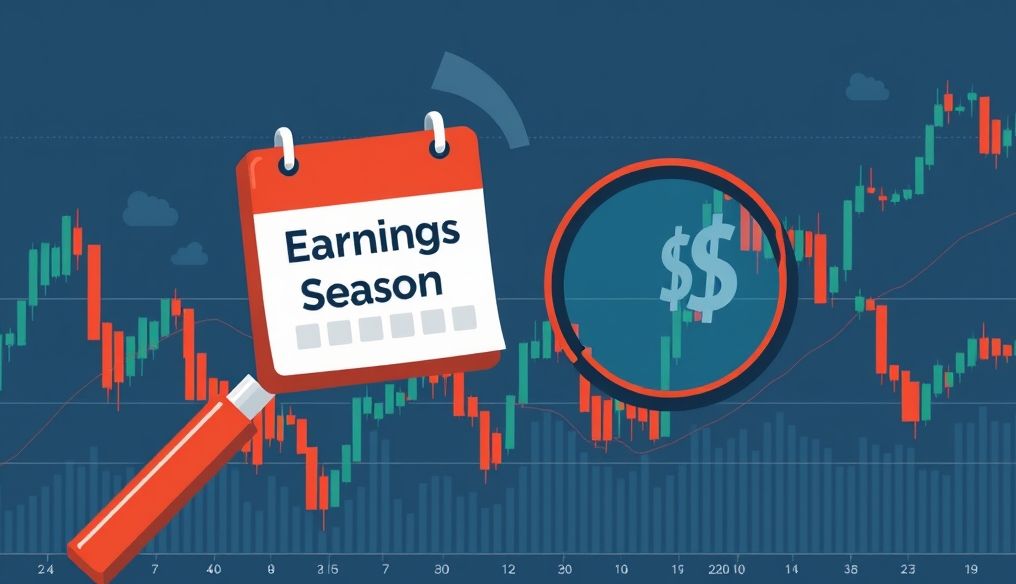Introduction: Earnings Season - Opportunity or Peril?
Earnings season is a critical period in the financial markets when publicly traded companies release their quarterly or annual financial results. This period presents a golden opportunity for professional traders to achieve significant profits, but it also carries substantial risks for novice or unprepared traders. Price volatility is at its peak, and unexpected news can lead to violent market movements. In this article, we will explore smart trading strategies that can help you make the most of earnings season, focusing on how to avoid potential pitfalls.
Chapter 1: Understanding the Dynamics of Earnings Announcements
Before diving into trading strategies, it is essential to understand the dynamics of earnings announcements and how they impact the markets.
What are Earnings Announcements?
Earnings announcements are periodic financial reports (quarterly or annual) issued by companies listed on stock exchanges, detailing the company's performance over a specific period. These reports include detailed information on revenues, profits, expenses, cash flows, and the company's future outlook.
How do Earnings Announcements Affect the Markets?
Earnings announcements affect the markets in several ways:
- Price Volatility: Stocks often experience significant price volatility before and after earnings announcements, as traders and investors try to anticipate potential results.
- Change in Market Sentiment: Earnings announcements can affect overall market sentiment, especially if the results are better or worse than expected.
- Valuation Adjustments: Based on earnings results, analysts and investors may adjust their valuations of the company, affecting the stock price in the long term.
Chapter 2: Trading Strategies Before Earnings Announcements
There are several strategies traders can follow before earnings announcements, considering the potential risks.
Early Anticipation Strategy
This strategy relies on trying to predict earnings results before the official announcement. It requires a careful analysis of the company's past financial data, news related to the sector it belongs to, and relevant economic indicators. If you expect positive results, you can buy the stock before the announcement, and if you expect negative results, you can short the stock.
Example: If a technology company has launched a successful new product in the last quarter, and its sales have increased significantly, you might expect positive earnings results and buy the stock before the announcement.
Neutral Strategy
This strategy involves taking a neutral position before the earnings announcement by buying both call and put options for the same stock. This strategy allows you to profit from any significant movement in the stock price, regardless of its direction.
Chapter 3: Trading Strategies After Earnings Announcements
After the earnings announcement, other trading opportunities become available, but they also require extreme caution.
Trend Following Strategy
This strategy relies on following the trend that forms after the earnings announcement. If the stock price rises sharply after the announcement, you can buy the stock and follow the upward trend. If the stock price falls sharply, you can short the stock and follow the downward trend.
Example: If an airline announces higher-than-expected earnings, and the stock price rises by 10% after the announcement, you can buy the stock and follow the upward trend, with a stop-loss order to protect your profits.
Reversal Trading Strategy
This strategy relies on anticipating a trend reversal after the earnings announcement. If the stock price rises sharply after the announcement, this rise may be temporary, and you can short the stock in anticipation of a later decline. If the stock price falls sharply, this decline may be exaggerated, and you can buy the stock in anticipation of a later rise.
Chapter 4: Risk Management in Earnings Season
Risk management is an essential element of successful trading, especially in earnings season.
Determining Trade Size
You should determine the appropriate trade size based on the amount of capital you have available and the level of risk you are willing to take. Do not risk more than 1-2% of your capital on any single trade.
Setting Stop-Loss Orders
You should set stop-loss orders to protect your capital in case the market moves against you. The stop-loss level should be predetermined, based on your technical and fundamental analysis.
Portfolio Diversification
You should diversify your investment portfolio to reduce risk. Do not put all your money in one stock, but invest in a variety of stocks and sectors.
Chapter 5: Tools and Analyses Used
There are many tools and analyses that traders can use to make informed trading decisions in earnings season.
Fundamental Analysis
Fundamental analysis involves studying a company's financial data, evaluating its financial performance, and analyzing the economic and industrial factors that affect it. Fundamental analysis helps to determine the true value of the company and make long-term investment decisions.
Technical Analysis
Technical analysis involves studying price charts and using technical indicators to identify trends and price patterns. Technical analysis helps to identify appropriate entry and exit points for short-term trading.
Economic Calendar
The economic calendar provides information on important economic events that may affect the financial markets, such as earnings announcements, inflation data, and interest rate decisions. The economic calendar helps to anticipate potential market movements and make informed trading decisions.
Chapter 6: Practical Examples from the Arab Market
Let's take a look at some practical examples from the Arab market to illustrate how to apply trading strategies in earnings season.
Example 1: Saudi Aramco
Saudi Aramco is one of the largest companies listed on the Saudi stock market. Before its quarterly earnings announcement, many traders analyze oil prices, production, and sales to predict earnings results. If expectations are positive, traders may buy the stock before the announcement, and if expectations are negative, they may short the stock.
Example 2: Al Rajhi Bank
Al Rajhi Bank is one of the largest Islamic banks in the world. Before its quarterly earnings announcement, analysts study the performance of the banking sector, interest rates, and credit growth to predict earnings results. Traders can use this information to make informed trading decisions.
Chapter 7: Common Mistakes to Avoid
There are several common mistakes that traders make in earnings season, which should be avoided.
- Emotional Trading: You should avoid emotional trading and make decisions based on logical analysis and data.
- Gambling: You should avoid gambling in the financial markets and only trade when you have a clear strategy and a risk management plan.
- Ignoring Risk Management: You should not ignore risk management, determine the appropriate trade size, set stop-loss orders, and diversify your portfolio.
Chapter 8: Tips for Beginner Traders
If you are a beginner trader, here are some tips that can help you succeed in earnings season.
- Start with Small Amounts: Start trading with small amounts of money until you gain experience and confidence.
- Learn from Mistakes: Learn from your mistakes, try to understand the reasons for losses, and avoid repeating them in the future.
- Consult Experts: Consult experts and financial analysts, and seek advice before making any trading decisions.
Chapter 9: The Future of Trading in Earnings Season
Trading in earnings season is constantly evolving, with the emergence of new technologies and tools.
Artificial Intelligence
Artificial intelligence is beginning to play an increasingly important role in trading, as it can be used to analyze financial data, predict market movements, and make automated trading decisions.
Big Data
Vast amounts of data are now available that can be used to analyze markets and make informed trading decisions. Big data helps traders better understand market behavior and identify available investment opportunities.
Chapter 10: Conclusion
Earnings season is an exciting and rewarding opportunity for traders, but it also carries significant risks. By understanding the dynamics of earnings announcements, following smart trading strategies, and managing risk effectively, you can make the most of this period and avoid costly losses. Always remember that successful trading requires patience, discipline, and continuous learning.
"Earnings season is the time of year when a significant number of public companies release their quarterly earnings reports." - Investopedia



